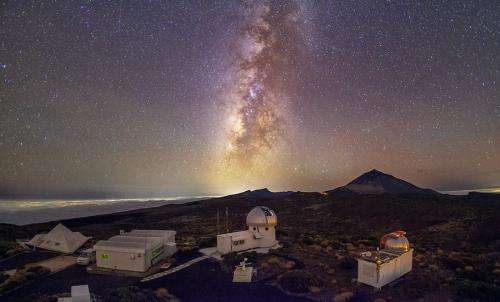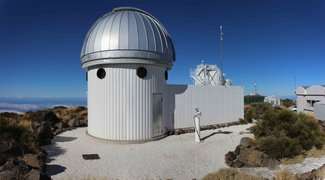New robotic telescope revolutionizes the study of stars

In the last 8 months a fully robotic telescope in Tenerife has been carrying out high-precision observations of the motion of stellar surfaces. The telescope is the first in the SONG telescope network and a milestone in a new global stellar research project, aiming at making it possible to follow the stars twenty-four seven.
Observations of stars and their planetary systems require long unbroken observations. This is needed to study 'starquakes', variations in the stellar light that tell us about the interior of stars in much the same way that earthquakes probe the Earth. Characterizing planetary systems around other stars also requires very extended observations. To do so from the ground requires a coordinated network of telescopes, and to keep the manpower manageable the telescopes must run automatically.
The first observatory in such a network has been developed by a group of Danish astronomers and is now in operation on the Spanish island Tenerife in the Canary Islands. This will be followed by very similar telescopes developed by participants in the project. The first results have demonstrated that global quakes in the Sun can be observed with an accuracy matching the best existing facilities, including those in space, while world-class data have also been obtained for two bright stars over several months.
The observatory is fully robotic: astronomers at Aarhus University upload a night's observing programme in the afternoon, possibly involving a number of stars. The software automatically starts observations at the appropriate time, switching between targets as instructed. If weather conditions deteriorate, observations are stopped and the dome is closed. Should conditions improve later at night, the observations are automatically restarted. At daybreak the observatory shuts down, and the accumulated data are made available for analysis by the astronomers when they get to work in the morning.
The potential of such a project, even based on telescopes of modest size, was realized some years ago by Danish astronomers. Based on this realization a Danish project was established to develop a new ultra-modern robotic telescope to serve as a prototype for the network. It should be inexpensive and efficient to run, and it should make a difference scientifically for relatively modest funds, even before the entire planned network had been built.
The prototype of the new telescope – and the first 'node' in the entire SONG network – has been erected and tested, and is now ready for the official inauguration on 25 October 2014 at the Teide Observatory of the Instituto de Astrofísica de Canarias (IAC) in Tenerife.
A dream comes true
At just 1 metre in diameter, the telescope is smaller than many other modern telescopes but optimized for the scientific goals of the project. The technical equipment is installed in an adjacent shipping container, and it can all be controlled remotely via an ordinary Internet connection. The price was EUR 4 million, which is cheap compared with similar telescopes elsewhere. Professor Jørgen Christensen-Dalsgaard is director of the Stellar Astrophysics Centre at Aarhus University, Denmark, and the overall leader of SONG. He is very pleased that the new telescope in Tenerife is now being used and has already started to provide outstanding scientific results.
"It's fantastic that we now have a new, ultra-modern telescope that can provide exactly what we dreamed of when the project kicked off. Our knowledge of stars and exoplanets has changed considerably in recent years, but we can nevertheless show that we were on the right track when we designed the scientific targets for the SONG project – and we should be very pleased with that," says Professor Christensen-Dalsgaard.
The search for Earth-like planets
One of the scientific aims of the new telescope is to locate planets around distant stars.
"The new telescope strengthens the capability to detect and explore Earth-like planets in our galaxy.
It is equipped with special technology that produces images that are almost as sharp as from space, which makes it possible to detect planets as small as Earth and Mars orbiting other stars," says Associate Professor Uffe Gråe Jørgensen, Niels Bohr Institute and Centre for Star and Planet Formation, University of Copenhagen. Professor Jørgensen is head of the SONG exoplanet research.
The SONG telescope lives up to its expectations, and not just in relation to the visions of the Danish astronomers. It has also fallen perfectly in place with both NASA's Kepler mission and major forthcoming space missions such as ESA's PLATO mission (PLAnetary Transits and Oscillations of stars) and NASA's TESS mission (Transiting Exoplanet Survey Satellite). The latter was not even on the drawing board when the SONG project commenced.
"SONG is the result of an impressive optimization of a small telescope, making it capable of powerful contributions to the identification of rocky planets that may be able to support life. SONG will be a key participating telescope in a follow-up network to sort through the many planet candidates expected to be found by the NASA TESS space mission", says Sara Seager, Professor of Planetary Science and Physics at the Massachusetts Institute of Technology and co-investigator on the TESS Mission.

SONG network expanded
The SONG telescope at the Observatio del Teide in Tenerife is owned and operated by Aarhus University, the University of Copenhagen and the Instituto de Astrofísica de Canarias.
"We are excited to host this new telescope at our observatory on Tenerife. Thanks to the long term collaboration with our Danish colleagues and the fact that there is a well reputed group at the IAC with experience in operating this kind of instrumentation, SONG decided to establish the prototype of the new telescope here," says Dr. Pere L. Pallé from Instituto de Astrofísica de Canarias , responsible scientist of the IAC-SONG collaboration.
In addition to the telescope in Tenerife, Chinese partners in the SONG collaboration are building a telescope in western China, which is based on the Danish prototype and is currently in the testing phase. Negotiations are also underway with partners in New Mexico, USA. The Chinese partners also have plans to build a SONG telescope in South America. Contacts are being established with other potential international partners to complete the network.

Inauguration
The Stellar Astrophysics Centre will host the official inauguration of the telescope at a ceremony at Observatorio del Teide (Tenerife) on 25 October 2014, attended by representatives from Aarhus University, the University of Copenhagen and Instituto de Astrofísica de Canarias , as well as relevant foundations. Other researchers from China, Australia, the USA, Chile, South Africa and Germany, who are either already participants in the SONG project or have expressed an interest in participating, will also attend the event.
The official name of the telescope will be The Hertzsprung SONG Telescope, named after the Danish astronomer Ejnar Hertzsprung (1873-1967). Ejnar Hertzsprung is known for the Hertzsprung-Russell diagram, which is a tool for classifying stars according to brightness and spectral types.
SONG stands for Stellar Observations Network Group.
Provided by Aarhus University



















